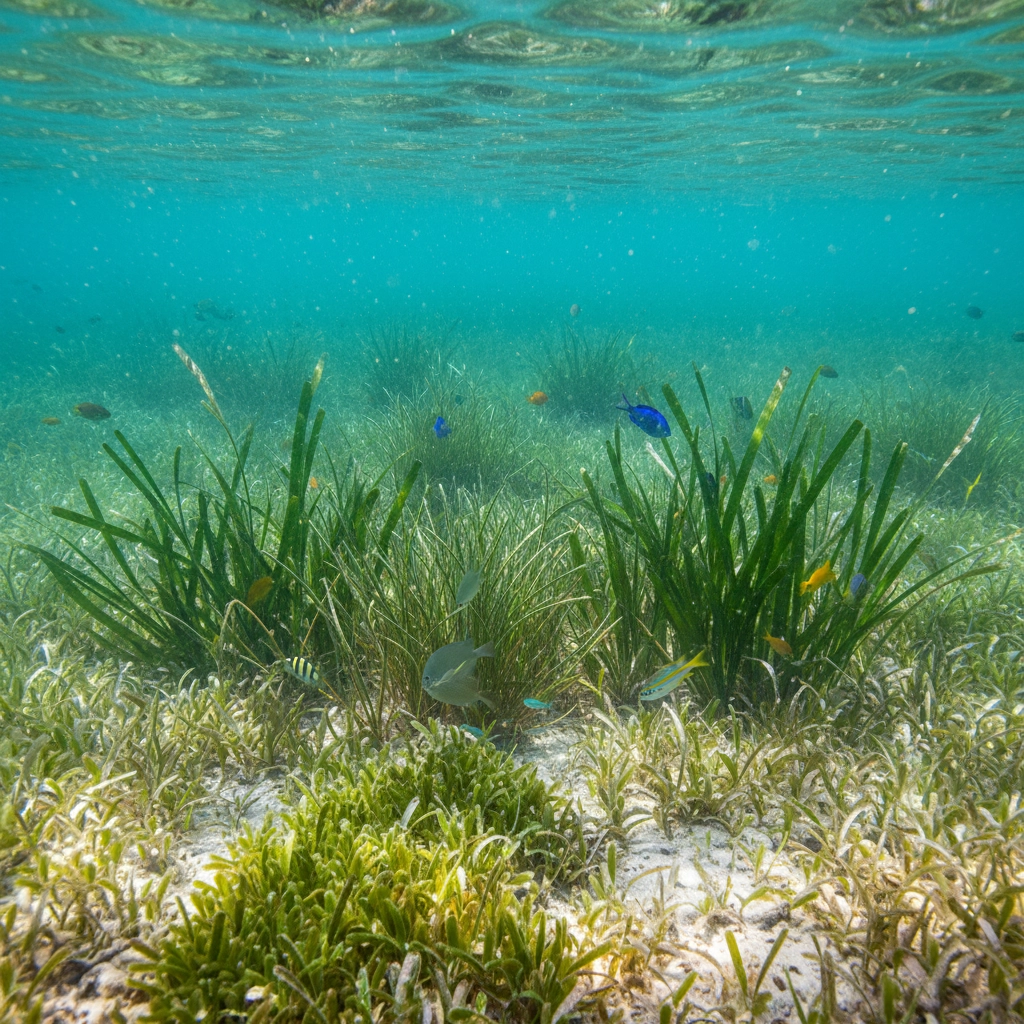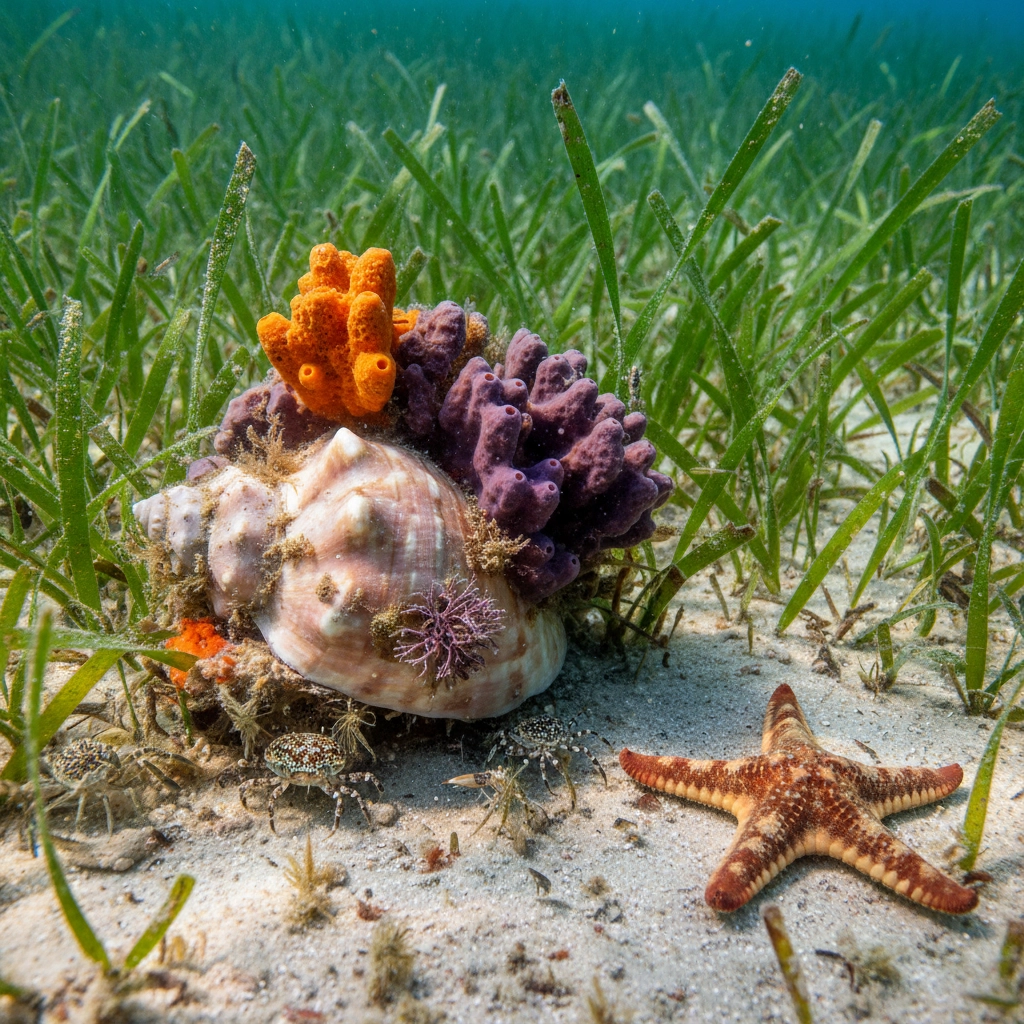Species Diversity in Seagrasses: The Florida Keys Nursery Habitat
- Caleb Mullenix
- Oct 19
- 5 min read
Understanding marine ecosystem dynamics is fundamental to comprehensive earth science education, and few environments offer students the opportunity to witness biodiversity in action quite like the seagrass meadows of the Florida Keys. These underwater grasslands represent one of the most productive ecosystems on Earth, serving as critical nursery grounds for an extraordinary diversity of marine life that students can observe, study, and help protect through hands-on marine science expeditions.
Ensuring that students grasp the ecological significance of these habitats while experiencing them firsthand creates unparalleled learning opportunities. The Florida Keys harbors approximately 1.5 million acres of seagrass meadows, making it one of the world's largest contiguous seagrass ecosystems. This vast underwater landscape provides educators with an exceptional outdoor classroom for school science trip Florida Keys experiences that combine rigorous scientific investigation with unforgettable field study.
The Foundation: Understanding Seagrass Ecosystems
Establish your students' foundation by teaching them that seagrass meadows function as the underwater equivalent of terrestrial prairies. Seven species of seagrass occur in Florida's waters, with three dominating the Florida Keys landscape: turtle grass (Thalassia testudinum), manatee grass (Syringodium filiforme), and shoal grass (Halodule wrightii). These marine flowering plants create three-dimensional underwater forests that transform barren sandy bottoms into thriving biological communities.
Direct students to observe the spatial variations between different seagrass beds during field studies. Research demonstrates that Gulf-side seagrass habitats exhibit significantly greater biodiversity, higher population densities, and more complex structural characteristics compared to Ocean-side locations. This geographic variation provides excellent opportunities for comparative ecological studies, allowing students to formulate hypotheses about environmental factors influencing ecosystem development.

The Nursery Habitat Function: A Critical Ecological Service
Emphasize to students that seagrasses earn their designation as nursery habitats through the protective underwater canopy they create. The complex blade structure provides essential shelter for small invertebrates, juvenile fish, and various crustaceans while they develop to maturity. This nursery function proves critically important for fisheries management, as 70% of commercially important fish species utilize seagrass ecosystems at some point in their life cycle.
Encourage students to document the remarkable density of life within these meadows during field observations. A single acre of seagrass can support upwards of 40,000 fish and 50 million small invertebrates, with populations often tens to hundreds of times greater than adjacent bare sandy areas. These statistics provide powerful teaching moments about habitat quality and species abundance relationships.
Create learning opportunities for students to understand why juvenile organisms prefer seagrass habitats over open sandy areas. The blade structure creates countless hiding places from predators while simultaneously providing abundant food resources. Students can observe this protection in action by comparing species diversity in seagrass beds versus nearby unvegetated areas during snorkeling activities.
Remarkable Species Diversity: From Microscopic to Megafauna
Fish Assemblages
Direct students' attention to the extraordinary fish diversity within seagrass meadows. Research has identified that white grunt (Haemulon plumierii), pinfish (Lagodon rhomboides), fringed filefish (Monacanthus ciliatus), and various mojarra species constitute nearly 70% of small-bodied fishes in these habitats. Students participating in earth science educational trips can learn fish identification techniques while observing these species in their natural environment.
Instruct students to note how fish abundance and species richness reach significantly higher levels in areas containing larger, denser, and more structurally complex seagrass beds. This correlation provides excellent opportunities to discuss habitat quality assessment and scientific methodology during field investigations.

Invertebrate Communities
Prepare students to discover an extraordinary array of invertebrate life during seagrass exploration. Crustaceans including shrimp, crabs, copepods, isopods, and amphipods find refuge among the grass blades, while mollusks such as queen conch, octopus, squid, snails, and bivalves inhabit these meadows alongside prominent species like Bahama sea stars.
Encourage students to examine seagrass blades closely to observe epiphytic organisms: bacteria, microalgae including diatoms, and various small invertebrates that grow directly on living seagrass leaves. This miniature ecosystem within an ecosystem provides excellent opportunities for microscopic investigation and discussion of symbiotic relationships.
Share with students that over 30 species of tropical invertebrates depending on seagrasses are collected in the Florida Keys annually for the marine aquarium industry, emphasizing the economic importance of these ecosystems beyond their ecological value.
Marine Megafauna
Advise students to remain alert for larger marine animals that rely heavily on Florida Keys seagrass meadows for feeding and habitat. Manatees and green sea turtles graze directly on seagrass vegetation, while various bird species including egrets forage in these shallow water habitats. Sharks, rays, and various marine mammals visit seagrass beds to feed on the abundant prey congregated there.

Student Field Study Opportunities with Appleseed Expeditions
Hands-On Research Techniques
Implement structured field study protocols that allow students to conduct authentic scientific research in seagrass habitats. Wildlife conservation student travel programs provide opportunities for students to use quadrat sampling techniques to measure seagrass density, document species composition, and assess habitat quality across different locations.
Establish student research teams to investigate the relationship between seagrass characteristics and animal abundance. Students can collect data on blade length, shoot density, and epiphyte coverage while simultaneously conducting fish and invertebrate surveys. This integrated approach reinforces ecological principles while developing quantitative research skills.
Water Quality Monitoring
Create opportunities for students to understand seagrass ecosystems' role in maintaining water quality. Students can measure dissolved oxygen levels, water clarity, nutrient concentrations, and sediment characteristics in seagrass beds versus adjacent unvegetated areas. These comparative studies demonstrate seagrasses' ecosystem services while teaching water quality assessment techniques.
Species Identification and Documentation
Develop student expertise in marine species identification through systematic field guides and underwater observation techniques. Students can create comprehensive species inventories, photograph organisms in their natural habitats, and maintain detailed field notebooks documenting behavior observations, habitat preferences, and species interactions.

Educational Value and Learning Applications
Interdisciplinary Learning Opportunities
Ensure that seagrass studies incorporate multiple scientific disciplines. Biology concepts include photosynthesis, food webs, predator-prey relationships, and adaptation strategies. Chemistry applications encompass nutrient cycling, pH measurements, and dissolved gas analysis. Physics principles include light penetration, wave action effects, and pressure relationships at different depths.
Real-World Conservation Applications
Connect student observations to current conservation challenges facing seagrass ecosystems. Discuss threats including coastal development, water pollution, propeller scarring, and climate change impacts. Students can participate in seagrass restoration monitoring, document human impacts, and develop conservation action plans based on their field observations.
Data Analysis and Scientific Communication
Emphasize the importance of data analysis and scientific communication skills through seagrass research projects. Students should graph their findings, calculate statistical relationships, and present their results to peers, parents, and community members. These communication skills prove invaluable for developing scientific literacy and public engagement capabilities.

Maximizing Learning Impact Through Comprehensive Preparation
Pre-Trip Preparation
Begin comprehensive preparation weeks before departure by researching seagrass ecology, reviewing species identification materials, and establishing research questions. Create detailed itineraries that balance structured learning activities with opportunities for independent observation and discovery.
Safety and Environmental Stewardship
Emphasize safety protocols for marine environments while stressing the importance of minimizing human impact on these sensitive ecosystems. Discuss proper snorkeling techniques, marine life interaction guidelines, and Leave No Trace principles specific to marine environments.
Assessment and Reflection
Develop assessment strategies that evaluate both scientific knowledge gained and personal growth experienced through field study. Encourage students to maintain detailed journals, complete species identification quizzes, and reflect on their changing understanding of marine ecosystem complexity.
Long-Term Educational Impact
The comprehensive study of species diversity in Florida Keys seagrass habitats through marine science expeditions provides students with foundational understanding of marine ecology while developing critical thinking, research methodology, and environmental stewardship skills. These experiences create lasting connections between students and marine environments, often inspiring career interests in marine science, conservation biology, or environmental education.
Ensure that students understand their role as future ocean stewards by connecting their seagrass studies to broader environmental challenges and conservation solutions. The hands-on experience of studying these remarkable nursery habitats while participating in school science trip Florida Keys programs creates powerful, lasting memories that reinforce the importance of marine ecosystem protection for current and future generations.
Through careful preparation, structured field investigations, and comprehensive follow-up activities, educators can maximize the transformative potential of seagrass ecosystem studies, ensuring that students gain both scientific knowledge and environmental awareness that will serve them throughout their academic and professional careers.



Comments